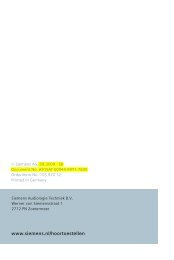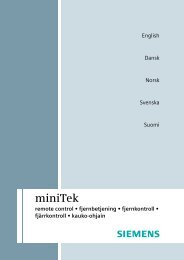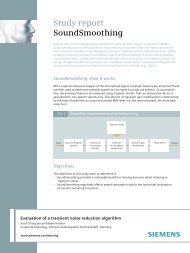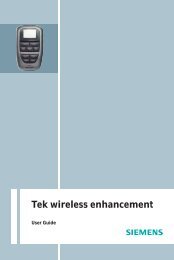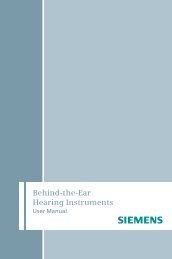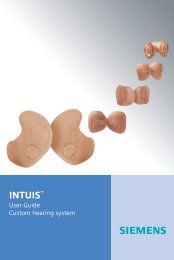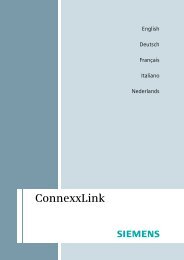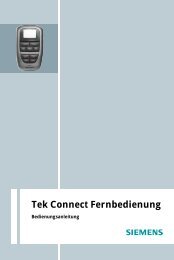CENTRA Active: A new receiver-in-canal solution designed to ...
CENTRA Active: A new receiver-in-canal solution designed to ...
CENTRA Active: A new receiver-in-canal solution designed to ...
Create successful ePaper yourself
Turn your PDF publications into a flip-book with our unique Google optimized e-Paper software.
Background <strong>in</strong>formation on RIC technology<br />
Corporate Audiology, Siemens Audiologische Technik GmbH, Germany<br />
www.siemens.com/hear<strong>in</strong>g<br />
<strong>CENTRA</strong> <strong>Active</strong>:<br />
A <strong>new</strong> <strong>receiver</strong>-<strong>in</strong>-<strong>canal</strong><br />
<strong>solution</strong> <strong>designed</strong> <strong>to</strong> enhance<br />
patient satisfaction<br />
Page 2 I Introduction<br />
Page 2 II A style and substance <strong>solution</strong><br />
Page 5 III Product <strong>in</strong>formation<br />
Page 7 IV Acoustic advantages<br />
Page 8 V Research results<br />
Page 9 VI Fitt<strong>in</strong>g guidel<strong>in</strong>es<br />
Page 10 VII Summary<br />
Page 11 References<br />
Abstract<br />
One of the biggest fitt<strong>in</strong>g challenges for hear<strong>in</strong>g care professionals is handl<strong>in</strong>g the<br />
high expectations of both <strong>new</strong> and experienced hear<strong>in</strong>g <strong>in</strong>strument wearers. With<br />
modern technology, wearers seek high speech <strong>in</strong>telligibility <strong>in</strong> noise and a high level<br />
of overall listen<strong>in</strong>g comfort <strong>in</strong> a variety of acoustic environments. In addition, research<br />
<strong>in</strong>dicates that consumers want hear<strong>in</strong>g <strong>in</strong>struments that are discrete, easy <strong>to</strong> use,<br />
comfortable <strong>to</strong> wear, and robust. <strong>CENTRA</strong> <strong>Active</strong> comb<strong>in</strong>es the latest advancements<br />
<strong>in</strong> signal process<strong>in</strong>g with <strong>receiver</strong>-<strong>in</strong>-<strong>canal</strong> (RIC) technology and a series of proprietary<br />
<strong>in</strong>novations <strong>to</strong> meet these requirements. This approach allows a feedback-free and<br />
occlusion-free fitt<strong>in</strong>g for a wide range of hear<strong>in</strong>g losses. Behavioral studies show that<br />
<strong>CENTRA</strong> <strong>Active</strong> also provides an outstand<strong>in</strong>g spontaneous acceptance. The special<br />
acoustics of <strong>CENTRA</strong> <strong>Active</strong> are discussed <strong>in</strong> detail and guidel<strong>in</strong>es for fitt<strong>in</strong>g and<br />
handl<strong>in</strong>g are given.
I<br />
Introduction<br />
II<br />
A style and<br />
substance<br />
<strong>solution</strong><br />
2<br />
Introduction<br />
One major advancement <strong>in</strong> hear<strong>in</strong>g <strong>in</strong>strument technology<br />
over the years has been observed <strong>in</strong> the <strong>in</strong>troduction<br />
of <strong>new</strong> algorithms <strong>in</strong> the digital signal<br />
process<strong>in</strong>g. Notable examples of this from Siemens<br />
are e2e wireless technology (Powers & Bur<strong>to</strong>n<br />
2005), SoundSmooth<strong>in</strong>g (Keidser et al. 2007,<br />
Chalupper & Powers 2007) and the Learn<strong>in</strong>g Volume<br />
Control (“DataLearn<strong>in</strong>g”) (Dillon et al. 2006, Chalupper<br />
& Powers 2006). Research has shown that these<br />
advancements enhance patient benefit.<br />
In addition <strong>to</strong> <strong>in</strong>novations <strong>in</strong> signal process<strong>in</strong>g, there<br />
is a need for advancements that will <strong>in</strong>crease patient<br />
acceptance of hear<strong>in</strong>g <strong>in</strong>struments. Consumer surveys<br />
(Kochk<strong>in</strong> 2002), <strong>in</strong>dicate that many hear<strong>in</strong>g aid<br />
users desire hear<strong>in</strong>g <strong>in</strong>struments which are discrete,<br />
easy <strong>to</strong> use, comfortable <strong>to</strong> wear and provide overall<br />
listen<strong>in</strong>g comfort. It is therefore important, that advancements<br />
<strong>in</strong> signal process<strong>in</strong>g be comb<strong>in</strong>ed with<br />
other <strong>in</strong>novations – for example <strong>in</strong> style and ease of<br />
use – <strong>to</strong> accommodate the other desired attributes<br />
of hear<strong>in</strong>g <strong>in</strong>struments and ultimately lead <strong>to</strong> <strong>in</strong>creased<br />
use and benefit.<br />
A style and substance <strong>solution</strong><br />
A <strong>new</strong> hear<strong>in</strong>g <strong>in</strong>strument from Siemens, <strong>CENTRA</strong><br />
<strong>Active</strong>, comb<strong>in</strong>es the advanced and cl<strong>in</strong>ically proven<br />
signal process<strong>in</strong>g strategies of the <strong>CENTRA</strong> hear<strong>in</strong>g<br />
<strong>in</strong>strument family with <strong>new</strong> design and handl<strong>in</strong>g<br />
features <strong>to</strong> enhance cosmetics, usability and patient<br />
wear<strong>in</strong>g comfort. <strong>CENTRA</strong> <strong>Active</strong> <strong>in</strong>cludes the follow<strong>in</strong>g<br />
digital signal process<strong>in</strong>g features from the successful<br />
<strong>CENTRA</strong> product family:<br />
• SoundSmooth<strong>in</strong>g<br />
• Learn<strong>in</strong>g Volume Control (“DataLearn<strong>in</strong>g”)<br />
• e2e wireless<br />
• Au<strong>to</strong>matic, multichannel adaptive directional<br />
microphone<br />
• Speech and noise management with Wiener Filter<br />
and modulation-based digital noise reduction<br />
• Adaptive high-speed feedback cancellation system<br />
• Data logg<strong>in</strong>g<br />
• ePocket option<br />
• 16-channel compression system<br />
<strong>CENTRA</strong> <strong>Active</strong> also employs other <strong>new</strong> unique features<br />
<strong>designed</strong> <strong>to</strong> enhance user acceptance. In recent<br />
years, the beh<strong>in</strong>d-the-ear (BTE) open <strong>canal</strong> (OC)<br />
hear<strong>in</strong>g <strong>in</strong>strument has enjoyed <strong>in</strong>creased popularity.<br />
As reviewed by Mueller (Mueller 2006), there<br />
are many advantages <strong>to</strong> OC fitt<strong>in</strong>gs, and patient surveys<br />
have shown that these <strong>in</strong>struments provide improved<br />
benefit and satisfaction (G<strong>new</strong>ikow and Moss<br />
2006; Taylor 2006). One advantage of the OC fitt<strong>in</strong>g<br />
is <strong>in</strong> regard <strong>to</strong> cosmetics – an important concern for<br />
most consumers. With <strong>receiver</strong>-<strong>in</strong>-<strong>canal</strong> BTEs, the<br />
BTE itself can be relatively small s<strong>in</strong>ce the <strong>receiver</strong>,<br />
one of the largest components, is placed outside the<br />
<strong>in</strong>strument’s hous<strong>in</strong>g <strong>in</strong><strong>to</strong> the ear <strong>canal</strong>. This of<br />
course makes the hear<strong>in</strong>g <strong>in</strong>strument less visible and<br />
more cosmetically appeal<strong>in</strong>g. The th<strong>in</strong> wire used <strong>to</strong><br />
transfer the signal <strong>to</strong> the <strong>receiver</strong> <strong>in</strong> the ear <strong>canal</strong> is<br />
also th<strong>in</strong>ner and less conspicuous than typical earmold<br />
tub<strong>in</strong>g.<br />
When <strong>receiver</strong>s are placed <strong>in</strong> the ear <strong>canal</strong>, as <strong>in</strong> cus<strong>to</strong>m<br />
<strong>in</strong>struments and the RIC design, it is critical that<br />
an effective and efficient wax protection device is<br />
used (Branda & Chalupper 2007). Such a device,<br />
referred <strong>to</strong> as “C-Guard,” is a standard feature for all<br />
<strong>CENTRA</strong> <strong>Active</strong> products. C-Guard is one of the three<br />
unique components of <strong>CENTRA</strong> <strong>Active</strong>’s AquaProtect<br />
(Siemens 2007) feature. In comb<strong>in</strong>ation with a<br />
unique GORE exchangeable microphone cover and<br />
nanocoat<strong>in</strong>g, AquaProtect shields <strong>CENTRA</strong> <strong>Active</strong><br />
from perspiration, water and dirt. This provides additional<br />
wear<strong>in</strong>g comfort and reliability when used<br />
outside, or for participat<strong>in</strong>g <strong>in</strong> sports or other activities<br />
where there is a high moisture level surround<strong>in</strong>g<br />
the hear<strong>in</strong>g <strong>in</strong>strument.<br />
<strong>CENTRA</strong> <strong>Active</strong> also <strong>in</strong>cludes a rechargeable feature.<br />
<strong>CENTRA</strong> <strong>Active</strong>’s charger option provides additional<br />
handl<strong>in</strong>g comfort and ease of use as there is no need<br />
<strong>to</strong> change batteries.<br />
These <strong>in</strong>novations unite the style and substance required<br />
for a modern hear<strong>in</strong>g <strong>in</strong>strument that meets<br />
the requirements for <strong>to</strong>day’s active wearers.<br />
<strong>CENTRA</strong> <strong>Active</strong> comb<strong>in</strong>es the cl<strong>in</strong>ically proven signal<br />
process<strong>in</strong>g strategies of <strong>CENTRA</strong> with <strong>new</strong> design<br />
and handl<strong>in</strong>g features.
Product <strong>in</strong>formation<br />
While <strong>CENTRA</strong> <strong>Active</strong> conta<strong>in</strong>s the same technology as<br />
the proven <strong>CENTRA</strong> family, there are some unique aspects<br />
<strong>to</strong> its design and the method by which it is fitted<br />
<strong>in</strong> the ear <strong>canal</strong>.<br />
Fig. 1 Components of the external<br />
<strong>receiver</strong><br />
Figure 1: Components of the external <strong>receiver</strong> <strong>in</strong>clud<strong>in</strong>g the<br />
dome with C-Guard and the <strong>receiver</strong> hous<strong>in</strong>g.<br />
<strong>CENTRA</strong> <strong>Active</strong>’s <strong>receiver</strong> unit and dome are shown<br />
<strong>in</strong> Figure 1. The <strong>receiver</strong> unit consists of the <strong>receiver</strong><br />
wire, the hous<strong>in</strong>g spout, the <strong>receiver</strong> and the <strong>receiver</strong><br />
hous<strong>in</strong>g all <strong>in</strong>tegrated <strong>in</strong><strong>to</strong> one piece that securely<br />
attaches <strong>to</strong> the <strong>in</strong>strument body with a click<br />
and turn connection. The <strong>CENTRA</strong> <strong>Active</strong> dome tip<br />
<strong>in</strong>cludes an <strong>in</strong>tegrated C-Guard barrier membrane.<br />
This membrane prevents even liquid cerumen from<br />
impact<strong>in</strong>g the <strong>receiver</strong> (Branda & Chalupper 2007).<br />
The C-Guard membrane is slightly recessed from<br />
the tip of the dome <strong>to</strong> prevent damage <strong>to</strong> the membrane.<br />
Domes are easily but securely attached <strong>to</strong> the<br />
<strong>receiver</strong> spout tip, so that they can be changed as<br />
needed. <strong>CENTRA</strong> <strong>Active</strong> can be fit with either open<br />
or closed earpieces. Open domes are available <strong>in</strong><br />
three sizes (6, 8 and 10 mm) and closed domes are<br />
available <strong>in</strong> two sizes (8 and 10 mm).<br />
<strong>CENTRA</strong> <strong>Active</strong>’s <strong>receiver</strong> hous<strong>in</strong>g is ergonomically<br />
bent <strong>to</strong> assure easy <strong>in</strong>sertion and a comfortable fit <strong>in</strong><br />
the ear <strong>canal</strong>. In addition <strong>to</strong> comfort, the <strong>receiver</strong><br />
hous<strong>in</strong>g was carefully <strong>designed</strong> so that it fits appropriately<br />
around the bend of the ear <strong>canal</strong>, and the<br />
outlet is ma<strong>in</strong>ta<strong>in</strong>ed <strong>in</strong> the center of the <strong>canal</strong>. With<br />
a straight <strong>receiver</strong> hous<strong>in</strong>g, as is the case with other<br />
systems, there is a risk that the tip may be pushed<br />
aga<strong>in</strong>st the <strong>canal</strong> wall. In addition <strong>to</strong> discomfort, this<br />
may cause <strong>in</strong>creased feedback risk, reduction <strong>in</strong> the<br />
amplified signal, cerumen accumulation, and cause<br />
the <strong>receiver</strong> <strong>to</strong> work its way out of the <strong>canal</strong>.<br />
Acoustic advantages<br />
Spout<br />
Dome with <strong>in</strong>tegrated<br />
C-Guard membrane<br />
Receiver hous<strong>in</strong>g<br />
In addition <strong>to</strong> the cosmetic and “ease of use” benefits<br />
of <strong>CENTRA</strong> <strong>Active</strong>, there also are important acoustic<br />
advantages that have been optimized <strong>in</strong> the <strong>Active</strong><br />
design.<br />
Enhanced high frequencies<br />
As reviewed by Mueller (Mueller 2006), improved<br />
high frequency amplification is a desired attribute<br />
of OC fitt<strong>in</strong>gs. Mueller and Ricketts (Mueller and<br />
Ricketts 2006) demonstrate that when the coupl<strong>in</strong>g<br />
<strong>in</strong> the ear <strong>canal</strong> allows for a residual ear <strong>canal</strong> resonance,<br />
this resonance then contributes <strong>to</strong> the amplified<br />
signal. That is, <strong>in</strong> the region of the residual<br />
resonance, less amplifier ga<strong>in</strong> is needed <strong>to</strong> achieve<br />
desired ear <strong>canal</strong> SPL. This residual ear <strong>canal</strong> resonance<br />
usually is <strong>in</strong> the 2000-3000 Hz range – important<br />
frequencies for speech understand<strong>in</strong>g, especially<br />
<strong>in</strong> background noise.<br />
Acoustics of RIC and conventional BTE systems<br />
III<br />
Transmission <strong>to</strong> eardrum<br />
Feedback path<br />
Figure 2: Illustration of the sound transmission paths for<br />
the RIC and a conventional BTE, show<strong>in</strong>g both the transmission<br />
of the amplified sounds <strong>to</strong> the eardrum (REAR),<br />
and also the path of the sound back <strong>to</strong> the hear<strong>in</strong>g aid<br />
microphone (feedback path).<br />
The <strong>receiver</strong>-<strong>in</strong>-<strong>canal</strong> design most obviously<br />
differs from traditional BTEs because of the <strong>receiver</strong><br />
location <strong>in</strong> the ear <strong>canal</strong>. However, the<br />
schematic draw<strong>in</strong>gs <strong>in</strong> Figure 2 show that the<br />
acoustic sound transmission paths <strong>to</strong> the eardrum<br />
and <strong>to</strong> the hear<strong>in</strong>g <strong>in</strong>strument’s microphone<br />
are very similar for traditional BTEs and<br />
<strong>receiver</strong>-<strong>in</strong>-<strong>canal</strong> <strong>in</strong>struments. Because of this<br />
similarity, the probability of acoustic feedback<br />
with a <strong>receiver</strong>-<strong>in</strong>-<strong>canal</strong> <strong>in</strong>strument as compared<br />
<strong>to</strong> a traditional BTE will also be similar. Fac<strong>to</strong>rs<br />
that <strong>in</strong>fluence the occurrence of feedback <strong>in</strong>clude:<br />
the <strong>in</strong>tensity of the <strong>in</strong>put signal, the <strong>in</strong>tensity<br />
of the amplified signal <strong>in</strong> the ear <strong>canal</strong>,<br />
<strong>in</strong>dividual ana<strong>to</strong>my of the ear <strong>canal</strong> and outer<br />
ear, the openness of the fitt<strong>in</strong>g, and the location<br />
of the hear<strong>in</strong>g aid microphone. As shown<br />
<strong>in</strong> Figure 2, all of these contribut<strong>in</strong>g fac<strong>to</strong>rs are<br />
essentially the same for hear<strong>in</strong>g <strong>in</strong>struments<br />
with an external <strong>receiver</strong> and for traditional<br />
BTEs us<strong>in</strong>g the same earmold and microphone<br />
location. Similar considerations apply for the<br />
sound pressure level delivered <strong>to</strong> the eardrum.<br />
Product<br />
<strong>in</strong>formation<br />
IV<br />
Acoustic<br />
advantages<br />
3
IV<br />
Acoustic<br />
advantages<br />
4<br />
Ga<strong>in</strong> / dB<br />
Fig. 3 REOG of open and closed dome<br />
20<br />
15<br />
10<br />
5<br />
0<br />
-5<br />
-10<br />
-15<br />
REUG<br />
Dome closed<br />
Dome open<br />
-20<br />
100 500 1000 4000 10000<br />
Figure 3: Illustration of the real ear occluded ga<strong>in</strong> (REOG) for<br />
both the open and closed domes of <strong>CENTRA</strong> <strong>Active</strong>. The real<br />
ear unaided ga<strong>in</strong> (REUG) is shown for comparison.<br />
Figure 3 shows the real ear unaided ga<strong>in</strong> (REUG) for<br />
the open ear <strong>canal</strong>. Observe that there is 13-17 dB<br />
peak <strong>in</strong> the 2000 <strong>to</strong> 4000 Hz range. In a closed hear<strong>in</strong>g<br />
aid fitt<strong>in</strong>g this open ear advantage is elim<strong>in</strong>ated,<br />
as the <strong>canal</strong> is closed and resonant properties are<br />
altered. However, observe <strong>in</strong> the dark blue curve of<br />
Figure 3, when the <strong>receiver</strong> fitted <strong>in</strong> the open dome<br />
is placed <strong>in</strong> the <strong>canal</strong>, all the open ear effects rema<strong>in</strong>.<br />
The curve for the closed dome shows that there is<br />
nearly no difference <strong>to</strong> the REUG below 1 kHz, but<br />
significant attenuation at higher frequencies. The<br />
follow<strong>in</strong>g sections exam<strong>in</strong>e the consequences of<br />
these acoustic properties on occlusion and feedback<br />
stability.<br />
Occlusion reduction<br />
Frequency / Hz<br />
In addition <strong>to</strong> improved high frequency amplification,<br />
another desired benefit of <strong>CENTRA</strong> <strong>Active</strong> is the<br />
reduction of the occlusion effect. The occlusion effect,<br />
often described as a “hollowness” of one’s own<br />
voice, is known <strong>to</strong> be bothersome, and <strong>in</strong> some <strong>in</strong>stances,<br />
prevents <strong>in</strong>dividuals from us<strong>in</strong>g amplification.<br />
Physically, the occlusion effect relates <strong>to</strong> an <strong>in</strong><br />
<strong>in</strong>crease of sound pressure level at low frequencies<br />
<strong>in</strong>side the ear <strong>canal</strong>. While the curves shown <strong>in</strong> Figure<br />
3 suggest that the ear <strong>canal</strong> is not significantly<br />
occluded below 1 kHz, this is not a direct measure of<br />
the “occlusion effect,” as REOG is measured with an<br />
external signal.<br />
Fig. 4 Occlusion with open and<br />
closed dome<br />
Occlusion / dB<br />
12<br />
10<br />
8<br />
6<br />
4<br />
2<br />
0<br />
-2<br />
250 500<br />
Figure 4: Occlusion measurements for <strong>CENTRA</strong> <strong>Active</strong> fitted<br />
with both the open and closed dome. Results from MacKenzie<br />
2006 for occluded, 2 mm and OC tips shown for comparison.<br />
To confirm that <strong>CENTRA</strong> <strong>Active</strong>’s ear pieces do not<br />
cause an occlusion effect, test<strong>in</strong>g was conducted<br />
with ten <strong>in</strong>dividuals (five males and five females).<br />
Each subject was fitted with the most appropriate<br />
dome size and wire length. The amount of occlusion<br />
was measured by subtract<strong>in</strong>g the level <strong>in</strong> the<br />
open ear <strong>canal</strong> from the level <strong>in</strong> the test condition<br />
(open dome, closed dome). Subjects vocalized an<br />
“ee” dur<strong>in</strong>g the measurements <strong>to</strong> generate an “<strong>in</strong>ternal”<br />
test signal. The results of this test<strong>in</strong>g, us<strong>in</strong>g<br />
the open and closed dome are shown <strong>in</strong> Figure 4.<br />
For comparison, these mean f<strong>in</strong>d<strong>in</strong>gs are displayed<br />
with the mean data from MacKenzie and colleagues<br />
(MacKenzie et al. 2004), which illustrate the expected<br />
amount of occlusion for an occluded and open<br />
fitt<strong>in</strong>g, and a vented fitt<strong>in</strong>g (2-mm vent). No significant<br />
differences between female and male subjects<br />
were observed. Note that with <strong>CENTRA</strong> <strong>Active</strong>, negligible<br />
occlusion is present. Even with the tighter fitt<strong>in</strong>g<br />
closed dome, average occlusion is no more than<br />
2-3 dB – a value that would not be bothersome nor<br />
even noticeable for most patients.<br />
Smooth frequency response<br />
Frequency / Hz<br />
Occluded<br />
2 mm vent<br />
Open <strong>canal</strong><br />
Dome open<br />
Dome closed<br />
1000<br />
There is a direct relationship between sound quality<br />
and the smoothness of the frequency response. The<br />
<strong>receiver</strong> and coupl<strong>in</strong>g system of <strong>CENTRA</strong> <strong>Active</strong> were<br />
optimized <strong>to</strong> provide a smooth response, with extended<br />
amplification <strong>in</strong> the higher frequencies.<br />
Figure 5 illustrates measures taken <strong>in</strong> the ear of the<br />
KEMAR for both the open and closed domes. Notice<br />
that the frequency response of <strong>CENTRA</strong> <strong>Active</strong> is<br />
smooth throughout the frequency range, with high<br />
frequency amplification extend<strong>in</strong>g <strong>to</strong> 8000 Hz.
Insertion ga<strong>in</strong> / dB<br />
Fig. 5 Maximum <strong>in</strong>sertion ga<strong>in</strong> for open<br />
and closed dome<br />
50<br />
40<br />
30<br />
20<br />
10<br />
0<br />
Dome closed<br />
Dome open<br />
-10<br />
100 500 1000 4000 10000<br />
Figure 5: Measured maximum <strong>in</strong>sertion ga<strong>in</strong> (IG) for both the<br />
open and closed domes of <strong>CENTRA</strong> <strong>Active</strong>.<br />
Observe that for both domes, ga<strong>in</strong> <strong>in</strong> the higher frequencies<br />
is similar. Because there is less ear <strong>canal</strong> leakage<br />
with the closed dome, ga<strong>in</strong> with this fitt<strong>in</strong>g option<br />
is 10 <strong>to</strong> 15 dB higher <strong>in</strong> the lower frequencies.<br />
Feedback stability<br />
Frequency / Hz<br />
Maximum <strong>in</strong>sertion ga<strong>in</strong>, displayed for <strong>CENTRA</strong><br />
<strong>Active</strong> <strong>in</strong> Figure 5, can be practically applied only<br />
if feedback is absent. To accomplish this, the maximum<br />
ga<strong>in</strong> without feedback (also known as “critical<br />
ga<strong>in</strong>” or “maximum stable ga<strong>in</strong>”) must be larger than<br />
the maximum <strong>in</strong>sertion ga<strong>in</strong>. A commonly used<br />
method <strong>to</strong> determ<strong>in</strong>e the critical ga<strong>in</strong> for a given <strong>in</strong>dividual<br />
is an open loop ga<strong>in</strong> (“OLG”) measurement 1<br />
(see Dillon 2001 for review).<br />
Figure 6 shows the range (i.e. m<strong>in</strong>imum and maximum<br />
values) and mean of the OLG measurements<br />
for 50 subjects with <strong>CENTRA</strong> <strong>Active</strong> fitted with the<br />
closed dome. Observe that there is an extremely<br />
large <strong>in</strong>dividual variance – up <strong>to</strong> 40 dB for some frequencies!<br />
Some patients, especially <strong>in</strong> the low frequencies,<br />
have stable ga<strong>in</strong> values much larger than<br />
the maximum ga<strong>in</strong> of <strong>CENTRA</strong> <strong>Active</strong>. Note that the<br />
average OLG at 3000 Hz is about 30 dB; this is the<br />
frequency region where the SPL is typically the highest<br />
<strong>in</strong> the ear <strong>canal</strong>, and hence the probability of<br />
feedback is highest. The mean OLG <strong>in</strong> this region<br />
is about 10 dB below the maximum <strong>in</strong>sertion ga<strong>in</strong><br />
shown <strong>in</strong> Figure 5. Due <strong>to</strong> the large <strong>in</strong>dividual variability,<br />
OLG measurements are recommended. Because<br />
the open dome is less occlud<strong>in</strong>g (see Figure 3),<br />
the average stable ga<strong>in</strong> will be somewhat less at all<br />
frequencies than shown <strong>in</strong> Figure 6 for the closed<br />
dome.<br />
1 The critical ga<strong>in</strong> measurement <strong>in</strong> CONNEXX also applies the open<br />
loop ga<strong>in</strong> technique<br />
Fig. 6 OLG measurements: Range and<br />
mean for closed dome<br />
Open loop ga<strong>in</strong> / dB<br />
80<br />
70<br />
60<br />
50<br />
40<br />
30<br />
20<br />
10<br />
0<br />
Dome closed<br />
Dome open<br />
500 1000 4000<br />
Figure 6: The mean open loop ga<strong>in</strong> for <strong>CENTRA</strong> <strong>Active</strong> (closed<br />
dome), with m<strong>in</strong>imum and maximum values.<br />
With any OC fitt<strong>in</strong>g, the risk of feedback is higher<br />
than that of a closed fitt<strong>in</strong>g. This feedback risk <strong>in</strong>dicates<br />
the need for an effective feedback cancellation<br />
system. <strong>CENTRA</strong> <strong>Active</strong>’s feedback cancellation system<br />
provides between 10 and 20 dB additional stable<br />
ga<strong>in</strong>. Fac<strong>to</strong>rs that <strong>in</strong>fluence this are <strong>in</strong>dividual hear<strong>in</strong>g<br />
loss, <strong>in</strong>dividual ana<strong>to</strong>my and the acoustical situa-<br />
tion. S<strong>in</strong>ce the feedback path can vary by up <strong>to</strong> 20 dB<br />
<strong>in</strong> daily life conditions (e.g. due <strong>to</strong> chew<strong>in</strong>g or proximity<br />
<strong>to</strong> w<strong>in</strong>dows), a comb<strong>in</strong>ation of OLG optimization<br />
(e.g. by us<strong>in</strong>g OPEN) and an adaptive feedback<br />
canceller is able <strong>to</strong> provide feedback-free listen<strong>in</strong>g<br />
for most patients <strong>in</strong> daily life (Chalupper & Kasanmascheff<br />
2005).<br />
Research results<br />
Frequency / Hz<br />
As discussed, the acoustic benefits of <strong>CENTRA</strong> <strong>Active</strong><br />
are numerous. Therefore, whether these design attributes<br />
would translate <strong>to</strong> improved patient satisfaction<br />
was the subject of a recent study conducted<br />
at the Hörzentrum <strong>in</strong> Oldenburg, Germany. Twenty<br />
experienced hear<strong>in</strong>g <strong>in</strong>strument wearers with moderate<br />
symmetrical hear<strong>in</strong>g loss participated <strong>in</strong> the<br />
study. <strong>CENTRA</strong> <strong>Active</strong> was compared <strong>to</strong> three other<br />
premium OC hear<strong>in</strong>g <strong>in</strong>struments from major manufacturers.<br />
One of the comparative products also employed<br />
RIC technology, while the other two were traditional<br />
BTE designs with the <strong>receiver</strong>s located <strong>in</strong> the<br />
<strong>in</strong>strument hous<strong>in</strong>g.<br />
Each of the four hear<strong>in</strong>g <strong>in</strong>struments was fitted <strong>to</strong><br />
the subjects, and ear <strong>canal</strong> record<strong>in</strong>gs were made<br />
for three different sound examples: speech <strong>in</strong> quiet,<br />
speech <strong>in</strong> a background noise babble, and music<br />
(flute).<br />
IV<br />
Acoustic<br />
advantages<br />
V<br />
Research results<br />
5
V<br />
Research results<br />
VI<br />
Fitt<strong>in</strong>g<br />
guidel<strong>in</strong>es<br />
6<br />
Open loop ga<strong>in</strong> (OLG) measurement<br />
To understand the OLG technique, refer back <strong>to</strong><br />
Figure 2. This illustration shows that the sound<br />
travels through the hear<strong>in</strong>g aid <strong>to</strong> the <strong>receiver</strong><br />
and after it is delivered <strong>in</strong> the ear <strong>canal</strong>, a portion<br />
of the sound leaks back <strong>to</strong> the microphone<br />
and is picked up aga<strong>in</strong>. It is possible, therefore<br />
<strong>to</strong> th<strong>in</strong>k of sound as a “closed loop” (from microphone<br />
<strong>to</strong> microphone) for all types of hear<strong>in</strong>g<br />
<strong>in</strong>struments. When the OLG test<strong>in</strong>g is con-<br />
ducted, however, the hear<strong>in</strong>g aid signal process<strong>in</strong>g<br />
path is split between microphone and<br />
<strong>receiver</strong>. That is, the microphone signal is not<br />
forwarded <strong>to</strong> the <strong>receiver</strong>. Hence, the loop<br />
is opened, which is why it’s referred <strong>to</strong> as an<br />
“open loop” measure.<br />
Now imag<strong>in</strong>e what happens <strong>in</strong> the “closed loop”<br />
if there is no attenuation of the sound that<br />
leaves the <strong>receiver</strong>. As soon as any amount of<br />
ga<strong>in</strong> is applied, the sound will be amplified by<br />
this amount <strong>in</strong> each run through the closed<br />
loop. Because of the speed of sound, this cont<strong>in</strong>uous<br />
loop<strong>in</strong>g effect quickly drives the ga<strong>in</strong><br />
<strong>to</strong> the maximum output of the hear<strong>in</strong>g <strong>in</strong>strument.<br />
If there is a dom<strong>in</strong>ant frequency, there<br />
will be a whistle, or what has come <strong>to</strong> be<br />
known as feedback.<br />
Given this knowledge of the physics of sound,<br />
it becomes clear that the amount of attenuation<br />
<strong>in</strong> the feedback path directly <strong>in</strong>dicates how<br />
much ga<strong>in</strong> can be applied without feedback.<br />
Hence, if we simply measure the attenuation<br />
between the ear <strong>canal</strong> SPL and the microphone,<br />
we know the maximum stable ga<strong>in</strong>; this <strong>in</strong> fact<br />
is the OLG measurement. For example, if a <strong>to</strong>ne<br />
was generated with a known output of 80 dB<br />
SPL, and the microphone picks up this <strong>to</strong>ne via<br />
the feedback path and measures its level <strong>to</strong> be<br />
10 dB SPL, then, the maximum stable ga<strong>in</strong><br />
would be 70 dB at this frequency. It’s important<br />
<strong>to</strong> understand that this value is unrelated <strong>to</strong> the<br />
maximum ga<strong>in</strong> provided by the hear<strong>in</strong>g aid<br />
used <strong>to</strong> conduct the measurement. It simply <strong>in</strong>dicates<br />
the maximum stable ga<strong>in</strong> that potentially<br />
could be delivered, given the ear acoustics,<br />
earmold plumb<strong>in</strong>g and the microphone<br />
location of that particular fitt<strong>in</strong>g.<br />
These record<strong>in</strong>gs were then played back-<strong>to</strong>-back <strong>to</strong><br />
the participants us<strong>in</strong>g a paired-comparison paradigm.<br />
By us<strong>in</strong>g record<strong>in</strong>gs, the participants were bl<strong>in</strong>ded <strong>to</strong><br />
the products themselves, and fac<strong>to</strong>rs such as size of<br />
the hear<strong>in</strong>g <strong>in</strong>strument, comfort of the fitt<strong>in</strong>g, etc.,<br />
were not confound<strong>in</strong>g variables. In each round, all<br />
products were compared <strong>to</strong> each other, and <strong>in</strong> each<br />
comparison, the participant was <strong>in</strong>structed <strong>to</strong> pick<br />
a “w<strong>in</strong>ner” (the hear<strong>in</strong>g <strong>in</strong>strument that they would<br />
prefer <strong>to</strong> use). In the case that two <strong>in</strong>struments<br />
sounded the same, the subject was <strong>to</strong> <strong>in</strong>dicate that<br />
as well. The complete round-rob<strong>in</strong> procedure was<br />
repeated two times, result<strong>in</strong>g <strong>in</strong> a <strong>to</strong>tal of 18 comparisons<br />
for each hear<strong>in</strong>g <strong>in</strong>strument.<br />
Fig. 7 Preference <strong>in</strong> direct comparison<br />
W<strong>in</strong>s / %<br />
50<br />
40<br />
30<br />
20<br />
10<br />
0<br />
Figure 7: Percent of w<strong>in</strong>s <strong>in</strong> paired comparison test for three<br />
different listen<strong>in</strong>g conditions. Data represents pair<strong>in</strong>gs where<br />
differences were noted.<br />
The results of this research are illustrated <strong>in</strong> Figure 7.<br />
Shown are the percent of w<strong>in</strong>s for each product for<br />
each listen<strong>in</strong>g condition. As all devices were premium<br />
products, <strong>in</strong> several of the comparisons, no difference<br />
could be detected. However, observe that<br />
when differences were noted, <strong>CENTRA</strong> <strong>Active</strong> consistently<br />
had the most w<strong>in</strong>s for all three listen<strong>in</strong>g conditions.<br />
These f<strong>in</strong>d<strong>in</strong>gs reveal that even when compared<br />
<strong>to</strong> the highest level of competition, the signal<br />
process<strong>in</strong>g and acoustics of <strong>CENTRA</strong> <strong>Active</strong> have a<br />
dist<strong>in</strong>ct advantage.<br />
Fitt<strong>in</strong>g guidel<strong>in</strong>es<br />
In general, fitt<strong>in</strong>g decisions and procedures concern<strong>in</strong>g<br />
<strong>CENTRA</strong> <strong>Active</strong> are similar <strong>to</strong> other members of<br />
the <strong>CENTRA</strong> family. There are some specific issues <strong>to</strong><br />
consider for <strong>CENTRA</strong> <strong>Active</strong>, however, that will be<br />
discussed <strong>in</strong> this section.<br />
Fitt<strong>in</strong>g range<br />
<strong>CENTRA</strong><br />
<strong>Active</strong><br />
HI #2<br />
Speech <strong>in</strong> noise<br />
Speech <strong>in</strong> quiet<br />
Music<br />
HI #3<br />
HI #4<br />
As shown <strong>in</strong> Figure 8, <strong>CENTRA</strong> <strong>Active</strong> is appropriate<br />
for a wide range of hear<strong>in</strong>g losses. In observ<strong>in</strong>g the<br />
fitt<strong>in</strong>g range, it’s important <strong>to</strong> consider that the upper<br />
limit of the fitt<strong>in</strong>g range for Siemens hear<strong>in</strong>g
<strong>in</strong>struments is calculated based on NAL-NL1, Acclimatization<br />
Level 2 – <strong>in</strong>clud<strong>in</strong>g 5-10 dB headroom <strong>to</strong><br />
allow for the peaks of speech, temporary VC adjustments,<br />
and/or progressive hear<strong>in</strong>g loss.<br />
Fig. 8 Fitt<strong>in</strong>g range<br />
Hear<strong>in</strong>g loss / dB HL<br />
dB<br />
0<br />
20<br />
40<br />
60<br />
80<br />
100<br />
120<br />
Closed domes<br />
Open domes<br />
125 250 500 1k 2k 4k 8k<br />
Frequency / Hz<br />
Figure 8: The shaded areas on the audiogram represent the<br />
recommended fitt<strong>in</strong>g range for <strong>CENTRA</strong> <strong>Active</strong> with open and<br />
closed domes.<br />
Receiver selection and replacement<br />
The <strong>receiver</strong> unit is available <strong>in</strong> three different wire<br />
lengths; the most appropriate length can be easily<br />
determ<strong>in</strong>ed for each patient us<strong>in</strong>g the <strong>CENTRA</strong> <strong>Active</strong><br />
measur<strong>in</strong>g gauge. The <strong>receiver</strong> assembly is easy <strong>to</strong><br />
attach and remove (see Figure 9). To remove, simply<br />
rotate the “turn-and-click” connection counter-clockwise<br />
(noticeable click). To attach, take the <strong>new</strong> re-<br />
Summary<br />
ceiver and then turn the connection clockwise (noticeable<br />
click). This easy process is also used <strong>to</strong> replace<br />
damaged <strong>receiver</strong>s <strong>in</strong> office and elim<strong>in</strong>ates the need<br />
<strong>to</strong> send out the hear<strong>in</strong>g aid for <strong>receiver</strong> repair.<br />
Fig. 9 Receiver selection & replacement<br />
Figure 9: Illustration of the procedure for replac<strong>in</strong>g the external<br />
<strong>receiver</strong> of <strong>CENTRA</strong> <strong>Active</strong>.<br />
Prescriptive algorithm<br />
<strong>to</strong> open<br />
Programm<strong>in</strong>g <strong>CENTRA</strong> <strong>Active</strong> requires Siemens fitt<strong>in</strong>g<br />
software CONNEXX 5.4, Sifit database 5.4.2. First Fit<br />
can be performed us<strong>in</strong>g the follow<strong>in</strong>g fitt<strong>in</strong>g algorithms:<br />
Siemens OPEN (Chalupper & Kasanmascheff<br />
2005), NAL-NL1 or DSL. The OPEN algorithm uses<br />
NAL-NL1 as the audiologic rationale <strong>to</strong> calculate <strong>in</strong>put<br />
frequency-specific ga<strong>in</strong> and output values. In<br />
addition, the OPEN formula au<strong>to</strong>matically optimizes<br />
the frequency response if it is predicted that the<br />
NAL-NL1 output values will exceed critical ga<strong>in</strong>. In<br />
most cases because of <strong>CENTRA</strong> <strong>Active</strong>’s fast-act<strong>in</strong>g<br />
feedback cancellation system, the NAL-NL1 targets<br />
can be met, so the OPEN algorithm is a conservative<br />
approach <strong>to</strong> further guard aga<strong>in</strong>st unwanted feedback.<br />
Research and anecdotal evidence alike <strong>in</strong>dicate that hear<strong>in</strong>g <strong>in</strong>strument wearers desire hear<strong>in</strong>g <strong>in</strong>struments<br />
that are discrete, easy <strong>to</strong> use, comfortable <strong>to</strong> wear, provide overall listen<strong>in</strong>g comfort and<br />
perform <strong>in</strong> a variety of acoustic environments. Research also <strong>in</strong>dicates that these patients receive<br />
significant benefit from the latest algorithms and special features available with modern hear<strong>in</strong>g <strong>in</strong>struments.<br />
The goal, therefore, when a <strong>new</strong> product is <strong>in</strong>troduced, is <strong>to</strong> couple the <strong>new</strong> advanced algorithms<br />
with <strong>new</strong> appeal<strong>in</strong>g hear<strong>in</strong>g aid designs as well as ergonomic advances. <strong>CENTRA</strong> <strong>Active</strong> meets<br />
this goal by accommodat<strong>in</strong>g all these desired attributes, and more.<br />
Us<strong>in</strong>g the latest <strong>receiver</strong>-<strong>in</strong>-<strong>canal</strong> technology, this <strong>in</strong>novative product provides a wide range of ga<strong>in</strong> and<br />
output, a smooth extended frequency response and an occlusion-free fitt<strong>in</strong>g. Innovations <strong>in</strong> handl<strong>in</strong>g,<br />
robustness and design have also been achieved. Moreover, cl<strong>in</strong>ical trial results have supported patient’s<br />
preference of <strong>CENTRA</strong> <strong>Active</strong> over other premium <strong>solution</strong>s. In summary, <strong>CENTRA</strong> <strong>Active</strong> meets the requirements<br />
of a wide range of patients, and its design and features are expected <strong>to</strong> further enhance<br />
patient benefit and satisfaction.<br />
VI<br />
Fitt<strong>in</strong>g<br />
guidel<strong>in</strong>es<br />
VII<br />
Summary<br />
7
Siemens<br />
Audiologische Technik GmbH<br />
Gebbertstrasse 125<br />
91058 Erlangen<br />
Germany<br />
Phone +49 (9131) 308-0<br />
www.siemens.com/hear<strong>in</strong>g<br />
References<br />
Powers, T. A., Bur<strong>to</strong>n, P. (2005).<br />
Wireless technology <strong>designed</strong> <strong>to</strong> provide true b<strong>in</strong>aural<br />
amplification.<br />
Hear<strong>in</strong>g Journal, 58 (1), 25 – 34.<br />
Keidser, G., O‘Brien, A., Latzel, M., Convery, E. (2007).<br />
Evaluation of a noise reduction algorithm that targets<br />
non-speech transient sounds.<br />
Hear<strong>in</strong>g Journal, 2007, <strong>in</strong> press.<br />
Chalupper, J., Powers, T. A. (2007).<br />
SoundSmooth<strong>in</strong>g: A New Algorithm <strong>to</strong> Reduce the<br />
Annoyance of Noise.<br />
Hear<strong>in</strong>g Journal, <strong>in</strong> press.<br />
Dillon, H., Zakis, J. A., McDermott, H., Keidser, G.,<br />
Dreschler, W., Convery, E. (2006).<br />
The tra<strong>in</strong>able hear<strong>in</strong>g aid: What will it do for clients and<br />
cl<strong>in</strong>icians?<br />
Hear<strong>in</strong>g Journal, 59(4), 31-36.<br />
Chalupper, J., Powers, T. A. (2006).<br />
Chang<strong>in</strong>g How Ga<strong>in</strong> is Selected: The Benefits of Comb<strong>in</strong><strong>in</strong>g<br />
Datalogg<strong>in</strong>g and a Learn<strong>in</strong>g VC.<br />
Hear<strong>in</strong>g Review, 13 (13), 46-55.<br />
Kochk<strong>in</strong>, S. (2002).<br />
MarkeTrak VI: Consumers Rate Improvements Sought <strong>in</strong><br />
Hear<strong>in</strong>g Instruments.<br />
Hear<strong>in</strong>g Review, 9(11) November 2002, 18-22.<br />
Siemens Audiologische Technik (2007).<br />
A Rechargeable Battery System for Hear<strong>in</strong>g Instruments.<br />
Siemens Audiologische Technik (2007).<br />
AquaProtect: Three Innovative Features <strong>to</strong> Protect aga<strong>in</strong>st<br />
Moisture.<br />
Branda E., Chalupper J. (2007).<br />
An Efficient and Effective Method <strong>to</strong> Protect Hear<strong>in</strong>g<br />
Instruments aga<strong>in</strong>st Moisture and Cerumen.<br />
Hear<strong>in</strong>g Review, submitted.<br />
Dillon, H. (2001).<br />
Hear<strong>in</strong>g <strong>in</strong>struments.<br />
New York: Thieme, 2001.<br />
G<strong>new</strong>ikow, D., Moss, M. (2006).<br />
Hear<strong>in</strong>g aid outcomes with open and closed <strong>canal</strong> fitt<strong>in</strong>gs.<br />
Hear<strong>in</strong>g Journal, 59 (11), 66-72.<br />
MacKenzie, D. (2006).<br />
Open-<strong>canal</strong> fitt<strong>in</strong>gs and the hear<strong>in</strong>g aid occlusion effect.<br />
Hear<strong>in</strong>g Journal, 59 (11), 50-56.<br />
Mueller, H. G. (2006).<br />
Open is <strong>in</strong>.<br />
Hear<strong>in</strong>g Journal, 59 (11), 11-14.<br />
Mueller, H. G., Ricketts, T. (2006).<br />
Open-<strong>canal</strong> fitt<strong>in</strong>gs: Ten take-home tips.<br />
Hear<strong>in</strong>g Journal, 59 (11), 24-39.<br />
Taylor, B. (2006).<br />
Real-world satisfaction and benefit with open-<strong>canal</strong> fitt<strong>in</strong>gs.<br />
Hear<strong>in</strong>g Journal, 59 (11), 74-82.<br />
Chalupper, J., Kasanmascheff, R. (2005).<br />
Us<strong>in</strong>g psychoacoustic models for fitt<strong>in</strong>g ski-slope hear<strong>in</strong>g<br />
losses.<br />
In: Hear<strong>in</strong>g aid fitt<strong>in</strong>g – Proceed<strong>in</strong>gs of 21st Danavox<br />
Symposium 2005, 619-630.<br />
Edi<strong>to</strong>rs: Rasmussen, Poulsen, Andersen, Simonsen, Larsen,<br />
Holmen Center Tryk, Kold<strong>in</strong>g.




